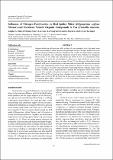| dc.contributor.author | Odak, Jenipher A. | |
| dc.contributor.author | Owuor, P. Okinda | |
| dc.contributor.author | Mang’uro, Lawrence O.A. | |
| dc.contributor.author | Wachira, Francis N. | |
| dc.contributor.author | Cheramgoi, Evelyne | |
| dc.date.accessioned | 2018-06-28T11:00:21Z | |
| dc.date.available | 2018-06-28T11:00:21Z | |
| dc.date.issued | 2017 | |
| dc.identifier.citation | Odak, J.A.; Owuor, P.O.; Mang’uro, L.O.A.; Wachira, F.N.; Cheramgoi, E. (2017). Influence of nitrogen fertilisation on red spider mites (Oligonychus coffeae Nietner) and overhead volatile organic compounds in tea (Camellia sinensis). International Journal of Tea Science, 13 (1&2), 52-59 | en_US |
| dc.identifier.issn | DOI: https://doi.org/10.20425/ ijts.v13i01-02.9985 | |
| dc.identifier.uri | https://repository.maseno.ac.ke/handle/123456789/652 | |
| dc.description.abstract | Nitrogen fertilisation influences tea yields, quality and pests infestation levels. Red spider mites reduce tea production in western Kenya during prolonged droughts. Nitrogen fertiliser use maybe an agronomic practice that may influence infestation levels by mites. Overhead volatile compounds (OVOCs) composition also influences infestations of tea by mites. Influence of nitrogenous fertiliser rates on red spider mite infestations and OVOCS levels was determined. Mites populations varied (pd<0.05) with nitrogenous fertiliser rates. High infestations were at 0 and 300 kg N/ha/year, and sharp decline between 150 and 225 kg N/ha/year. Green leaf volatiles increased while some aromatic and terpenoid compounds decreased with increasing nitrogenous fertiliser rates. Significant (pd<0.05) direct linear regressions between 1-penten-3-ol, 3-penten2-ol, E-2-hexenal, Z-3-hexenyl acetate and inverse relationship between 2-phenyl ethanol, ethyl benzene, -methyl styrene, longifolene and ß-cedrene and nitrogenous fertiliser rates were observed. Most aromatic and terpenoid compounds, which are repellents of mites, were highest between 150 and 225 kg N/ha/year where infestations by mites were lowest. The recommended
fertiliser rates of 100 to 225 kg N/ha/year in Kenya also produce most repellents of mites,
protecting tea plants against infestations. Use of recommended nitrogen rates can protect tea from infestations by mites. | en_US |
| dc.description.sponsorship | In ter national Foundation for Science (IFS) under Grant C/4714-2 | en_US |
| dc.publisher | International Journal of Tea Science Vol 13, No. 1&2 (2017) : 52-59 | en_US |
| dc.relation.ispartofseries | ;DOI: https://doi.org/10.20425/ ijts.v13i01-02.9985 | |
| dc.subject | Tea, overhead volatile organic compounds, mites, nitrogen fertiliser | en_US |
| dc.title | Influence of Nitrogen Fertilisation on Red Spider Mites (Oligonychus coffeae Nietner) and Overhead Volatile Organic Compounds in Tea (Camellia sinensis) | en_US |
| dc.type | Article | en_US |

